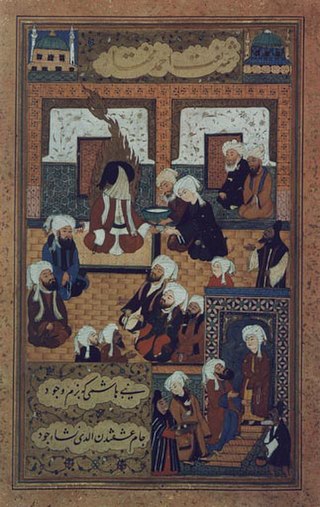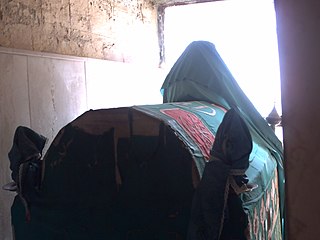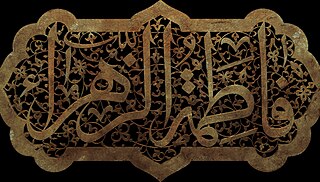
Abū Bakr ʿAbd Allāh ibn ʿAbī Quḥāfa was the senior companion and was, through his daughter Aisha, a father-in-law of the Islamic prophet Muhammad, as well as the first Caliph of the Rashidun Caliphate. He is known with the honorific title al-Siddiq by Sunni Muslims.

The Companions of the Prophet were the disciples and followers of Muhammad who saw or met him during his lifetime, while being a Muslim and were physically in his presence. "Al-ṣaḥāba" is definite plural; the indefinite singular is masculine صَحَابِيٌّ, feminine صَحَابِيَّةٌ.
Māriyya bint Shamʿūn, better known as Māriyyah al-Qibṭiyyah or al-Qubṭiyya, or Maria the Copt, died 637, was an Egyptian woman who, along with her sister Sirin bint Shamun, was given to the Islamic prophet Muhammad in 628 as a slave by Al-Muqawqis, a Christian governor of Alexandria, during the territory's Sasanian occupation. She spent the rest of her life in Medina and had a son, Ibrahim with Muhammad. The son died as an infant and she died almost five years later.
Eleven women were confirmed to be married to Islamic prophet Muhammad. Muslims use the term Umm al-Mu'minin prominently before or after referring to them as a sign of respect, a term derived from Quran 33:6.
This is a timeline of major events in the Muslim world from 601 AD to 700 AD.

Muhammad ibn Abi Bakr ibn Abi Quhafa al-Taymi was an Arab Muslim commander in the service of the fourth Rashidun caliph Ali.
Saʿīd ibn Zayd,, also known by his kunyaAbūʾl-Aʿwar, was a companion of the Islamic prophet Muhammad and a brother-in-law of Umar.

Banū Taym was a clan of the Quraysh tribe of Mecca. The first caliph, Abu Bakr, hailed from the Banu Taym, as did another prominent companion of Muhammad, Talha ibn Ubaydallah.

Asra Quratulain Nomani is an Indian American author. Born in India to Muslim parents, she earned a BA from West Virginia University in liberal arts in 1986 and an MA from the American University in international communications in 1990. She subsequently worked as a correspondent for The Wall Street Journal with her colleague Daniel Pearl in Pakistan post-9/11. Pearl was kidnapped and murdered by Islamist terrorists while following an investigative lead. Nomani later became the co-director of the Pearl Project, a faculty-student investigative-reporting project which has looked into Pearl's murder.
The Muhajirun were the converts to Islam and the Islamic prophet Muhammad's advisors and relatives, who emigrated from Mecca to Medina, the event is known in Islam as the Hijra. The early Muslims from Medina are called the Ansar ("helpers").

The Islamic prophet Muhammad came to the city of Medina following the migration of his followers in what is known as the Hijrah in 622. He had been invited to Medina by city leaders to adjudicate disputes between clans from which the city suffered. He left Medina to return to and conquer Mecca in December 629.
ʿĀʾisha bint Ṭalḥa was, according to a Sunni source, the daughter of the prominent Muslim general Talha ibn Ubayd Allah and Umm Kulthum bint Abi Bakr. Umm Kulthum was the daughter of the first Rashidun Caliph, Abu Bakr.

Fāṭima bint Muḥammad, commonly known as Fāṭima al-Zahrāʾ, was the daughter of the Islamic prophet Muhammad and his wife Khadija. Fatima's husband was Ali, the fourth of the Rashidun Caliphs and the first Shia Imam. Fatima's sons were Hasan and Husayn, the second and third Shia Imams, respectively. Fatima has been compared to Mary, mother of Jesus, especially in Shia Islam. Muhammad is said to have regarded her as the best of women and the dearest person to him. She is often viewed as an ultimate archetype for Muslim women and an example of compassion, generosity, and enduring suffering. It is through Fatima that Muhammad's family line has survived to this date. Her name and her epithets remain popular choices for Muslim girls.

The Jewel of Medina is a historical novel by Sherry Jones that recounts the life of Aisha, one of Muhammad's wives, from the age of six, when she was betrothed to Muhammad, to her death.
Aisha bint Abi Bakr was Islamic prophet Muhammad's third and youngest wife. In Islamic writings, her name is thus often prefixed by the title "Mother of the Believers", referring to the description of Muhammad's wives in the Qur'an.
The Shi'a view of Aisha is generally unfavourable. This is primarily due to what they see as her contempt for the Ahl al-Bayt and her actions in the First Fitna of the time. Her participation in the Battle of the Camel is widely considered her most significant sign of such contempt. Shi'a also consider Aisha to be a controversial figure because of her political involvement during her lifetime. Aisha came from a political family lineage, as she was the daughter of Abu Bakr, the first caliph. Aisha also played an active role in Muhammad's political life; she was known to accompany him to wars, where she learned military skills, such as initiating pre-war negotiations between combatants, conducting battles, and ending wars.
Asmāʾ bint Abī Bakr was one of the companions of the Islamic prophet Muhammad and half-sister of his third wife Aisha. She is regarded as one of the most prominent Islamic figures, as she helped Muhammad during the Hijrah from Mecca to Medina.

The Battle of the Camel took place outside of Basra, Iraq, in 36 AH. The battle was fought between the army of the fourth caliph Ali, on one side, and the rebel army led by Aisha, Talha and Zubayr, on the other side. Ali was the cousin and son-in-law of the Islamic prophet Muhammad, while Aisha was a widow of Muhammad, of whom Talha and Zubayr were both prominent companions. Ali emerged victorious from the battle, Talha and Zubayr were both killed, and Aisha was sent back to Hejaz afterward. The triumvirate had revolted against Ali ostensibly to avenge the assassination of the third caliph Uthman, although Aisha and Talha are both known to have actively opposed him. The three also called for the removal of Ali from office and for a Qurayshite council (shura) with Talha and Zubayr to appoint his successor.
Qurayba "the Younger" bint Abi Umayya, a companion of Muhammad, and was in succession, a wife of, the later second caliph Umar and the first Umayyad caliph Mu'awiya.









